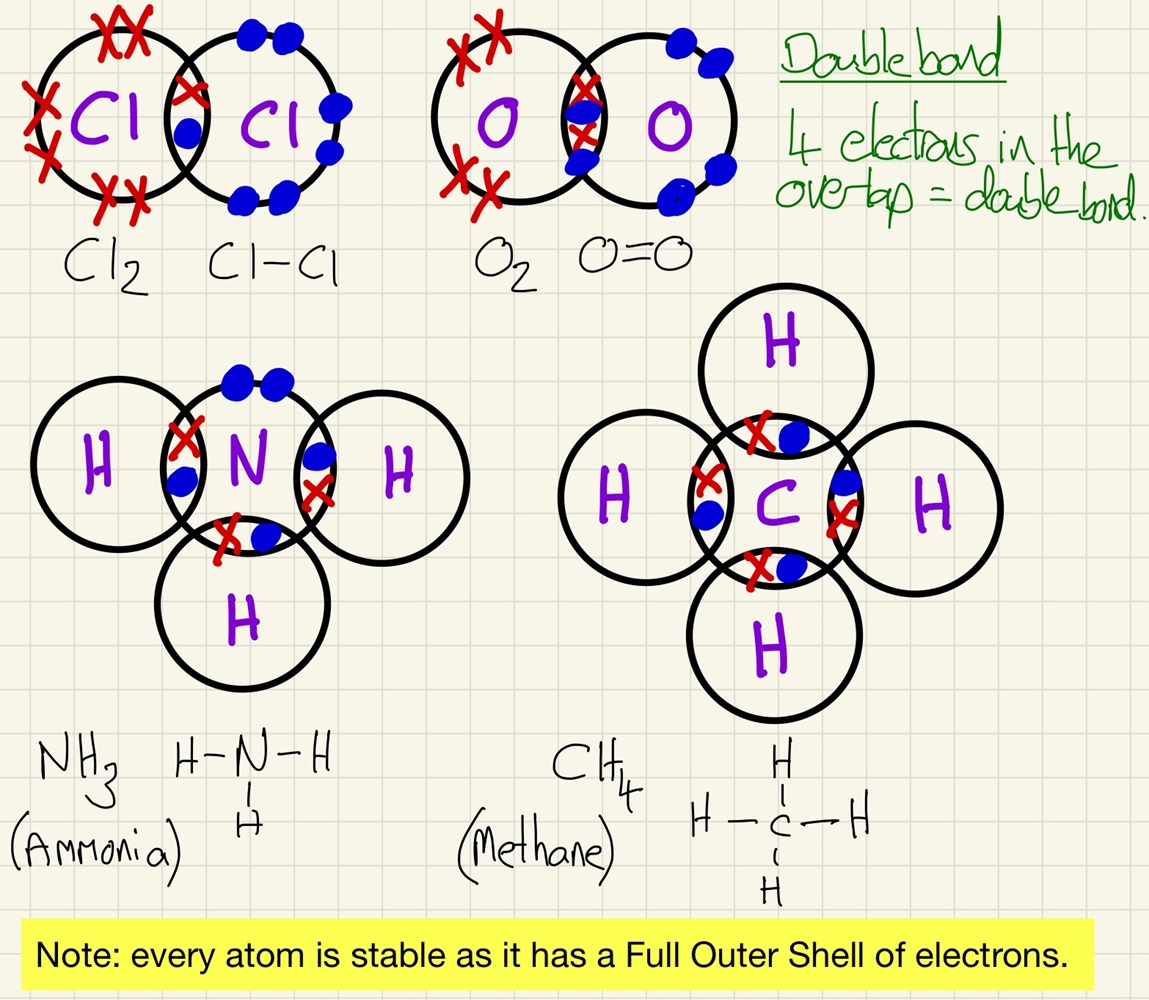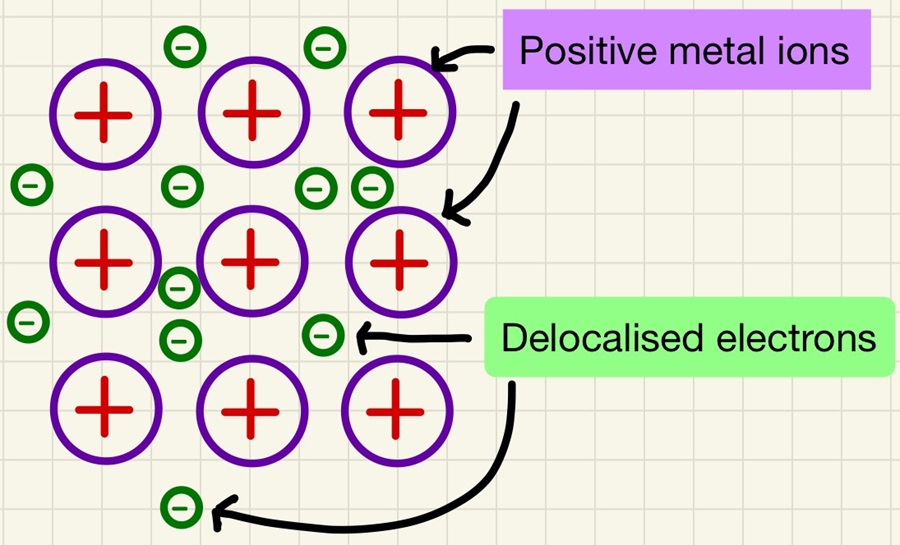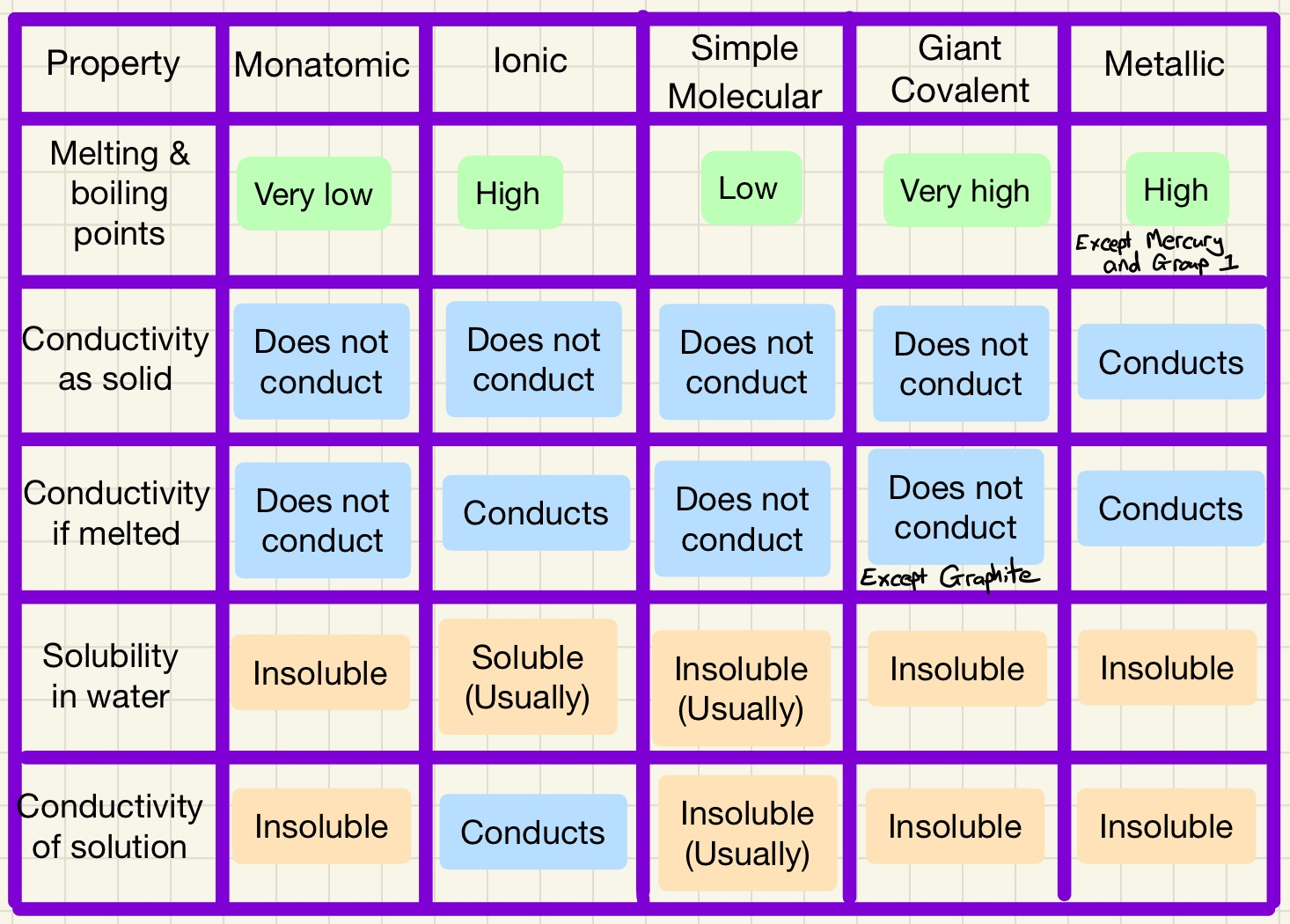Bonding, Structure and Properties
What we are learning:
Ionic bonding:

Ionic bonding occurs between metal and non-metals. In a reaction that results in an ionic compound being made, the metal atom gives up its outer electron(s) to form a positive ion and achieves a full outer shell of electrons. At the same time, the non-metal receives the electron(s) and fills its outer shell and forms a negative ion. Once this has happened, the ionic substance is a oppositely charged ions that are held together by strong electrostatic forces.
Covalent bonding:

Covalent bonds are formed between non-metals. Just like with the ionic bonding above, atoms are trying to achieve full outer shells for stability. Here, non-metals overlap their outer shells and share pairs of electrons. These covalent bonds are strong. You need to be able to recognise and draw the "dot and cross" diagrams for these and the best examples to cover are: Cl2, HCl, NH3, CH4 and to show a double bond (sharing 2 pairs of electrons) O2 and for a triple bond (sharing 3 pairs of electrons) N2.
Metallic bonding and monatomic substances:

Metallic bonding refers to the internal structure of metals and what keeps metal atoms together. Inside a metal, the metal atoms, like in ionic and covalent bonding, want to achieve stability by having a full outer shell of electrons. The metals eject their outer electron(s) and become positive ions. The ejected electrons move freely around the regular arrangement of positive ions (this is a giant structure). This is the sea of delocalised electrons. The attraction between the positive metal ions and the sea of delocalised electrons is the strong metallic bonding. This structure can be used to explain why metals conduct electricity (electrons move freely throughout the structure) and why metals conduct heat (the electrons absorb thermal energy and pass it on as they move freely throughout the structure). Most metals have a high melting point.
Monatomic substances are the Noble gases. These already have a full outer shell of electrons so are already stable and do not try to bond with other substances. As a result, they have very low melting and boiling points, are not soluble and do not conduct electricity.
States of Matter and state symbols:

There are three states of matter that we need to know about. Solid, liquid and gas. Substances have two points at which these states change, the first is the melting point at which melting and freezing take place and the second is the boiling point at which boiling and condensing take place. You need to be able to recognise and show how the particles are shown in a simple model.
Solid - particles touching and in a regular arrangement.
Liquid - particles touching but freely moving over each other.
Gas - particles far apart and filling the space available.
The strength of the attractions between the particles dictate the temperatures at which the substance melts and boils. If the intermolecular forces between molecules or the electrostatic forces between ions is strong, there will be a high melting point, if they are weak, there will be a low melting point.
We use symbols to represent the state of matter in equations.
Solid (s)
Liquid (l)
Gas (g)
Aqueous (aq) this means that it is dissolved in water.
Properties of ionic substances:

Ionic substances have a giant ionic lattice which is a 3D structure consisting of alternating positive and negative ions held together by strong electrostatic forces acting in all directions. These have high melting and boiling temperatures as a lot of energy will be needed to overcome these attractions and break up the lattice. Ionic solids are brittle.
Ionic substances cannot conduct electricity unless they are melted or dissolved in water. They cannot conduct unless there are free moving ions.
Properties of covalent substances (simple molecules):

Simple molecules are made of non-metals held together by strong covalent bonds. These molecules are attracted to each other by weak intermolecular forces. This means that there is not a lot of energy needed to overcome these weak intermolecular forces so the substances have a low melting and boiling point. As molecules get bigger, they need more energy to melt and boil them, this is why most simple molecules are a gas a room temperature. Notable exceptions are Water H2O(l), Bromine Br2(l) and Iodine I2(s).
In these simple molecules, there are no charge carriers (free moving ions or electrons) so they do not conduct electricity.
Giant covalent substances and the Allotropes of Carbon:

Giant covalent structures are formed by certain group 4 elements and their compounds. Silicon dioxide forms a giant 3D lattice in which the atoms of silicon and oxygen are held together by strong covalent bonds. Huge amounts of energy is needed to break all of these bonds so SiO2 has a very high melting temperature.
Carbon is the other group 4 element that forms giant covalent structures. In fact, it forms three different structures called allotropes
Diamond: each carbon forms 4 strong covalent bonds to other carbons, this lattice of strong bonds is the reason that diamond has such an extremely high melting point and is so strong.
Graphite: each carbon forms 3 strong covalent bonds to other carbons. The missing 4th bond means that there is an extra electron which becomes delocalised. Graphite is made from layers of hexagons with delocalised electrons between these layers (one electron per carbon). Combined, these produce the following properties - Very high melting point (not quite as high as diamond), conducts electricity (free moving/delocalised electrons between the layers) and finally, the layers can slide over each other making it a lubricant and pencil "lead". When you write with a pencil, graphite layers are sliding off the pencil and staying on the paper. A single layer of graphite is called graphene, it has applications in electronics and even phone screens.
Finally, we have the Fullerens. These are hollow spheres of carbon atoms in molecules such as C60. If stretched, these can form nanotubes.
The only giant covalent structures that conducts electricity are graphite and graphene.
Properties summary

Use this table to match the properties of a substance to its structure. Like playing "Guess Who", you can eliminate different structure types until you find the one that matches. Make sure that you can explain the properties too. Substances do not conduct if there are no free moving charge carriers (electrons in metals and graphite or ions in ionic substances).
Alloys and Polymers:

Alloys are made by adding small amounts of other metals or carbon to a metal. by adding a small amount of carbon to iron, you make steel Alloys are stronger than the original element because the different sized ion (remember that they are not atoms in metallic bonding) will disrupt the regular arrangement. This makes is very difficult for the ions to slide over each other. Some alloys are made for other special properties as well as strength, these include corrosion resistance, lustre and density. Smart alloys can return to specific shapes when heated.
Polymers or plastics have very specific properties that depend upon the combination of chemicals that they are made from. You will meet polymers in the organic module.
Key words/terms for this topic
Allotrope Alloy Charges Conductivity Conductor Covalent Delocalised electrons Diamond Electrostatic Attraction Free Moving Ions Fullerene Graphene Graphite Intermolecular Forces Ion Lattice Malleable Nanoparticles Polymers Simple Molecules Sublimation Surface area to volume ratio Transfer
Curriculum Health Check:
Q: An ion has a charge of 3-, which group is it from?
A: Group 4
B: Group 5
C: Group 7
D: Group 3
What you need to know
Ionic bonds are formed between metals and non-metals in a compound. Covalent bonds are formed with non-metals only. Metallic bonding is present in metals and alloys. You need to explain these bonds in terms of electron transfer and sharing.

Ionic compounds have specific properties such as high melting points, they are usually soluble and only conduct electricity if they are melted or dissolved in water (as they need free moving ions to conduct). They are held together by strong electrostatic forces.

Covalent molecules are also called simple molecules. This is because despite having very strong covalent bonds between the atoms, they have very weak intermolecular forces between molecules giving them very low melting ad boiling points. You need to be able to draw dot and cross diagrams for their structures.

In metallic bonding, you need to describe the regular arrangement of ions (remember that there are no atoms in metal, they are all ions) surrounded by the delocalised electrons (sea of electrons). This explains why metals can conduct both heat and electricity.

You need to describe the properties of polymers, giant covalent structures including the allotropes of carbon and different alloys (how adding different sized atoms can change the strength etc).

Linking to these properties, you need to understand the models of solids, liquids and gases. Accurately sue state symbols.

Extra topics needed for the Higher Tier papers:

For this, you need to be able to explain the limitations of the models we use for solids liquids and gases, for example, there are no forces between the molecules in this model and that the particles are shown as perfect spheres that do not change shape at all.

This page was updated on: 1st June 2024


